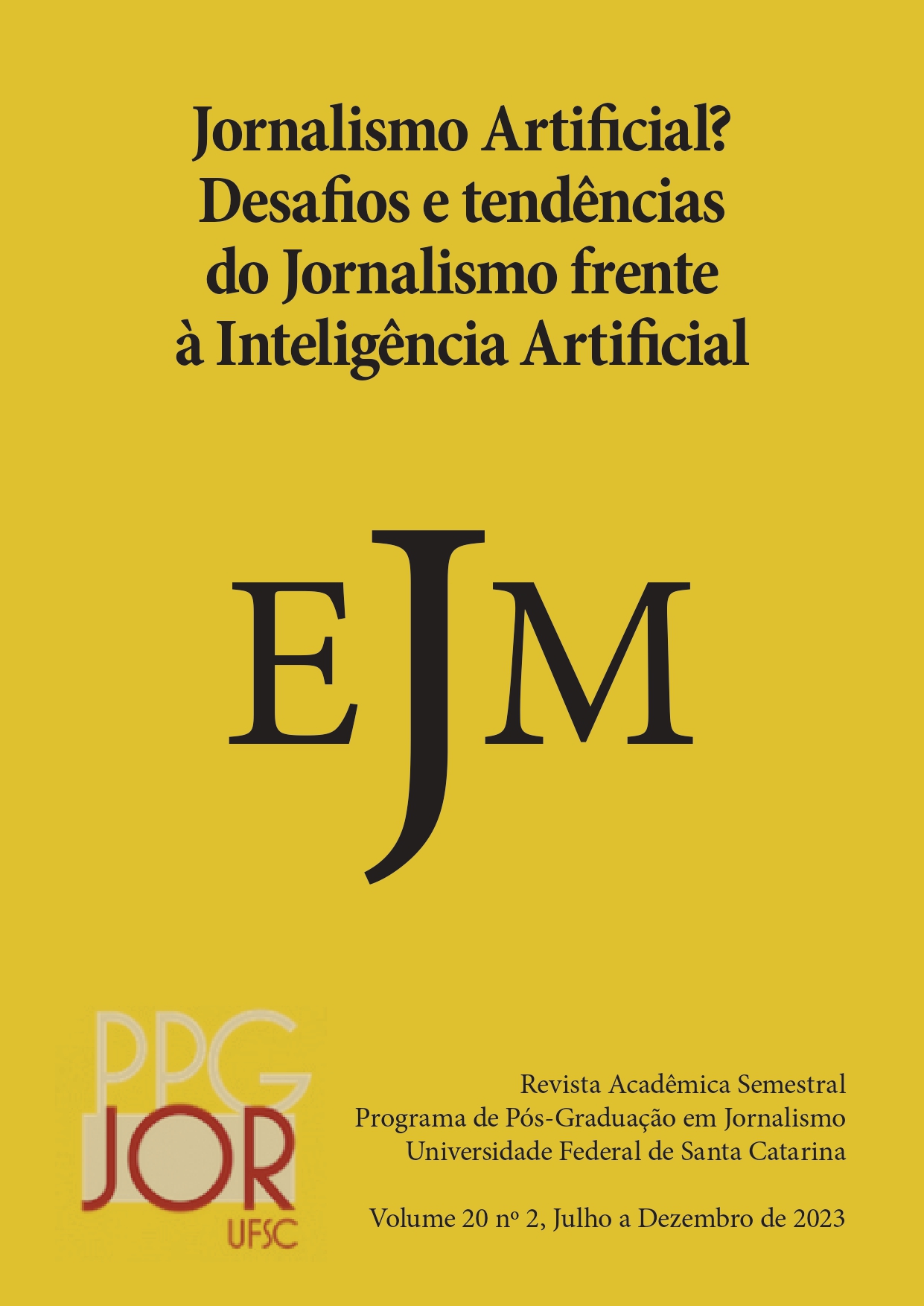Journalism in a new informative environment structured by Artificial Cognitive Systems
DOI:
https://doi.org/10.5007/1984-6924.2023.95083Keywords:
Journalism, Artificial Cognitive Systems, Social relevanceAbstract
Journalism has evolved over the centuries, adapting to capture the audience's attention. With the emergence of intelligent systems such as chatbots and software that transform data into news narratives, giving rise to Artificial Media, computational systems with cognitive bias create content in real-time through interactive engagement with the audience. This new information ecosystem blurs the boundaries between human-generated content and that produced by machines. The introduction of Artificial Cognitive Systems establishes a symbiotic partnership between biological and artificial agents, transforming the way information is consumed. This Human Information Interaction replaces the previous master-slave relationship from the Industrial Revolution. The article suggests the hypothesis of the consolidation of Artificial Media, in which the machine can process events, contexts, and actions, initially dealing with immediate situations and increasingly acquiring predictive or prospective capabilities, thus reshaping the production, distribution, and consumption of news.
References
ALBERS, M. Human-Information Interaction with Complex Information for Decision-Making. Informatics, v. 2, n. 2, p. 4–19, 2015.
C. LEWIS, S.; GUZMAN, A.; R. SCHMIDT, T. Automation, Journalism, and Human-Machine Communication: Rethinking Roles and Relationships of Humans and Machines in News. Digital Journalism, p. 1–19, 2019.
CARLISLE, J. H. Evaluating the impact of office automation on top management communication. National Computer Conference and Exposition. Anais...1976
CHEN, M.; HERRERA, F.; HWANG, K. Cognitive Computing: Architecture, Technologies and Intelligent Applications. IEEE Access, v. 6, p. 19774–19783, 2018.
DEUZE, M. What Journalism Is ( Not ). Social Media + Society, p. 1–4, 2019.
E. KELLY III, J.; HAMM, S. Smart Machines: IBM’s Watson and the Era of Cognitive Computing. New York: Columbia Business School, 2013.
FIDEL, R. Human Information Interaction?: An ecological approach to information behavior. London, England: MIT Press, 2012.
FORSYTHE, C.; BERNARD, M. L.; GOLDSMITH, T. E. Cognitive System: human cognitive models in Systems Design. Mahwah, New Jersey: Lawrence Erlbaum Associates, Inc., Publishers, 2006.
GRIFFITH, D. Beyond Usability: The New Symbiosis. Ergonomics in Design: The Quarterly of Human Factors Applications, v. 13, n. 3, p. 30–34, jun. 2005.
GRUDIN, J. A moving target: the evolution of human-computer interaction. In: JACKO, J. A. (Ed.). . The Human-Computer Interaction Handbook: Fundamentals, Evolving Technologies, and Emerging Applications. 3rd. ed. [s.l: s.n.]. p. 2.
GYNNILD, A. Journalism innovation leads to innovation journalism: The impact of computational exploration on changing mindsets. Journalism, v. 15, n. 6, p. 713–730, 2014.
LEV MANOVICH. The Language of New Media. Cambridge, MA, USA: MIT Press, 2002.
LICKLIDER, J. C. R. Man-Computer Symbiosis. IRE Transactions on Human Factors in Eletronics, p. 4–11, 1960.
LICKLIDER, J. C. R. Libraries of the future. [s.l.] MIT PRESS, 1965.
MARCHIONINI, G. Human- information interaction research and development. Library {&} Information Science Research, v. 30, p. 165–174, 2008.
MCSHANE, M. Natural Language Understanding (NLU, not NLP) in Cognitive Systems. AI Magazine, v. 38, n. 4, p. 43–56, 2017.
PAVLIK, J. V. Computing, Algorithms and Data: Transforming Journalism and MediaII Encontro Internacional de Tecnologia, Comunicação e Ciência Cognitiva (EITCCC), 2016a.
PAVLIK, J. V. Cognitive computing and journalism: implications of algorithms, artificial intelligence and data for the news media and society. Brazilian Journal of Technology, Communication, and Cognitive Science, v. 4, n. December 2016, p. 1–14, 2016b.
SARACEVIC, T. Relevance: A Review of the Literature and a Framework for Thinking on the Notion in information Science. Part II: Nature and Manifestations of Relevance. Journal of the American Society for Information Science and Technology, v. 58, n. 13, p. 1915–1933, 2007.
SCIFORCE. NLP vs. NLU: from Understanding a Language to Its ProcessingSciforce Blog, 2019. Disponível em: <https://medium.com/sciforce/>.
SHAPIRO, I. Why democracies need a functional definition of journalism now more than ever. Journalism Studies, v. 15, n. 5, p. 555–565, 2014.
SILVA, J. R.; LIMA JUNIOR, W. T. From Licklider to cognitive service systems. Brazilian Journal of Technology, Communication, and Cognitive Science, v. 5, n. 1, p. 13, 2017.
SINGH, S. Natural Language Processing for Information Extraction, 2018.
SPENCE, P. R. Searching for questions, original thoughts, or advancing theory: Human-machine communication. Computers in Human Behavior, v. 90, p. 285–287, 2019.
SPERBER, D.; WILSON, D. Relevance: Communication and Cognition. Second Edi ed. Cambridge, MA, USA: Blackwell, 1995.
TAYLOR, J. G. Cognitive computation. Cognitive Computation, v. 1, n. 1, p. 4–16, 2009.
VERNON, D. Artificial Cognitive Systems: a primer. Cambridge, Massachusetts: MIT Press, 2014.
Downloads
Published
Issue
Section
License
Ao encaminhar textos à revista Estudos em Jornalismo e Mídia, o autor estará cedendo integralmente seus direitos patrimoniais da obra à publicação, permanecendo detentor de seus direitos morais (autoria e identificação na obra), conforme estabelece a legislação específica. O trabalho publicado é considerado colaboração e, portanto, o autor não receberá qualquer remuneração para tal, bem como nada lhe será cobrado em troca para a publicação. As ideias e opiniões expressas no artigo são de exclusiva responsabilidade do autor, não refletindo, necessariamente, as opiniões da revista. Citações e transcrições são permitidas mediante menção às fontes. A revista Estudos em Jornalismo e Mídia está sob a Licença Creative Commons



